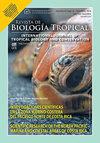巴西亚马孙飞禽(鹦鹉目:鹦鹉科)的再引入与监测
IF 0.6
4区 生物学
Q4 BIOLOGY
引用次数: 1
摘要
简介:重新引入是一种用于重建野生动物种群的程序。目的:本研究旨在评估重新引入Amazona aestiva的成功率,并调查非生物因素(温度、湿度和光度)是否会干扰在释放区安装的喂食器中寻找食物补充。方法:对59种Amazonas spp.进行释放前评估。对粪便寄生虫学测试、白细胞、飞行能力和动物-人类相互作用水平进行测试。总共选择了33只动物并将其送往放生区,该放生区位于大西洋森林和卡廷加生物群落之间。释放后,对喂食者的探访和该地区的存活情况进行了一年的监测。在这些时期也记录了非生物因素。结果:粪便寄生虫学测试显示存在Heterakis spp.和Eimeira spp.。白细胞参数在该物种的参考值范围内。至少50%的放生动物在一年后存活下来,并记录了繁殖事件。非生物因素不会干扰动物对喂食器的访问。然而,湿度的变化最能解释上午的访问,而温度和光度的变化对下午的访问影响最大。结论:在此观察和介绍的重新引入已达到成功分类的阈值。安装的喂食器和人工巢穴使这些动物留在该地区进行监测。非生物因素可能会影响重新引入的鹦鹉使用补充喂养的日常行为决策。本文章由计算机程序翻译,如有差异,请以英文原文为准。
Reintroduction and monitoring of the bird Amazona aestiva (Psittaciformes: Psittacidae) in Brazil
Introduction: Reintroduction is a procedure used to reestablish wild animal populations. Objective: The present study aimed to evaluate the success of reintroducing Amazona aestiva and investigate whether abiotic factors (temperature, humidily, and luminosity) interfere with the search for food supplementation in feeders installed in the release area. Methods: Pre-release evaluations were initiated with 59 Amazonas spp. Tests were run to stool parasitological tests, leukocytes, flight capacity, and level of animal-human interaction. In all, 33 animals were selected and sent to the release area, which is an ecotone between the Atlantic Forest and the Caatinga biomes. After release, visits to the feeders and survival in the area were monitored for a year. Abiotic factors were also recorded in these periods. Results: The stool parasitological tests revealed the presence of Heterakis spp. and Eimeira spp. The leukocyte parameters were within the reference values for the species. At least 50% of the released animals survived after one year, with recordings of reproductive events. Abiotic factors did not interfere with the animal visits to the feeder. However, the variable humidity best explained visits in the morning, while the variables temperature and luminosity most influenced visits in the afternoon. Conclusion: The reintroduction observed and presented here is on the threshold of the classification as successful. The installed feeders and artificial nests caused the animals to stay in the area for monitoring. Abiotic factors may influence daily behavioral decision-making related to the use of supplementary feeding in reintroduced parrots.
求助全文
通过发布文献求助,成功后即可免费获取论文全文。
去求助
来源期刊

Revista De Biologia Tropical
生物-生物学
CiteScore
1.80
自引率
0.00%
发文量
23
审稿时长
4-8 weeks
期刊介绍:
The Revista de Biología Tropical / International Journal of Tropical Biology and Conservation is a mainstream scientific journal published since 1953 and covered by Web of Science; Science Citation Index; Current Contents; Google Scholar; Scopus, SciELO and nearly 50 additional indices.
A double blind system guarantees you a fair evaluation, and our world class editorial and scientific boards provides a first decision in three working days. The journal is Full Open Access and is widely read where your article can have the highest real impact.
Since its beginning in 1953, the Revista follows these principles: objective and independent evaluation of all manuscripts; transparency in all processes; ethical use of procedures, data, specimens and subjects; fair treatment of all parties; and absolute predominance of scientific rigor over any other aspect.
 求助内容:
求助内容: 应助结果提醒方式:
应助结果提醒方式:


